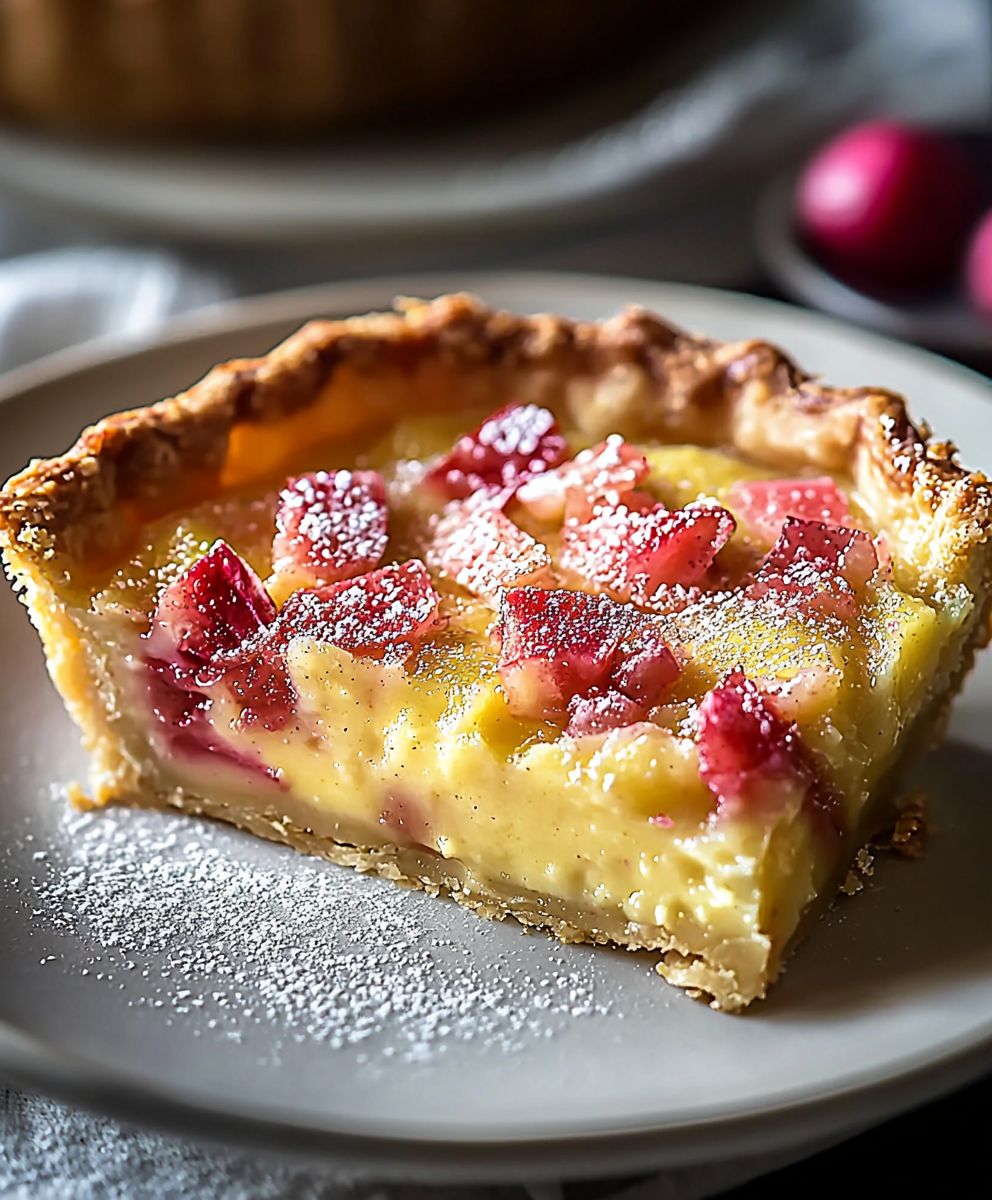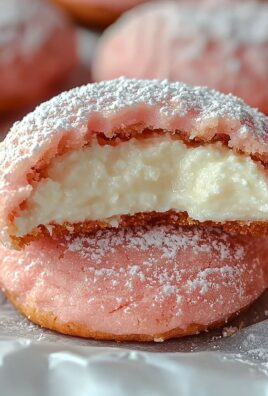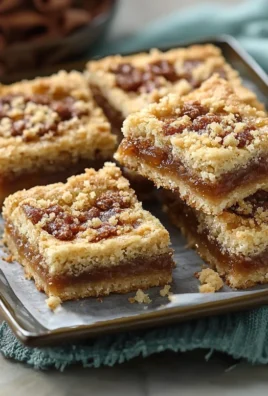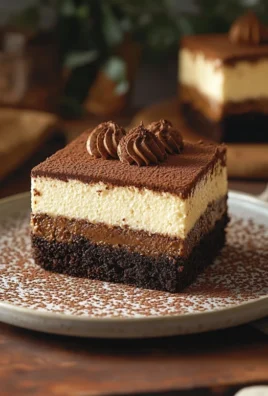Rhubarb Custard Pie: the very name evokes images of sunny spring days and the comforting aroma of a freshly baked dessert wafting through the kitchen. Have you ever experienced the delightful tang of rhubarb perfectly balanced by the creamy sweetness of custard, all nestled in a flaky, golden crust? If not, you’re in for a treat! This isn’t just a pie; it’s a slice of history and a taste of home.
Rhubarb, though often treated as a fruit, is actually a vegetable that has been enjoyed in pies and desserts for centuries. Its popularity soared in the Victorian era, becoming a staple in British and American gardens. The combination of tart rhubarb and sweet custard is a testament to culinary ingenuity, transforming a somewhat sour ingredient into a delectable masterpiece.
What makes rhubarb custard pie so irresistible? It’s the symphony of textures and flavors. The tender, slightly acidic rhubarb provides a refreshing counterpoint to the rich, velvety custard. The buttery, crisp pie crust adds another layer of indulgence. It’s a dessert that’s both comforting and exciting, perfect for a special occasion or a simple weeknight treat. Plus, it’s surprisingly easy to make, allowing you to impress your friends and family with minimal effort. Let’s get baking!
Ingredients:
- For the Crust:
- 1 1/4 cups all-purpose flour
- 1/2 teaspoon salt
- 1/2 cup (1 stick) cold unsalted butter, cut into small cubes
- 1/4 cup cold vegetable shortening, cut into small pieces
- 4-6 tablespoons ice water
- For the Rhubarb Filling:
- 4 cups fresh rhubarb, trimmed and cut into 1/2-inch pieces
- 1 cup granulated sugar
- 1/4 cup all-purpose flour
- 1/4 teaspoon ground nutmeg
- 1/4 teaspoon ground cinnamon
- 1 tablespoon lemon juice
- For the Custard:
- 3 large eggs
- 1 1/2 cups heavy cream
- 1/2 cup granulated sugar
- 1 teaspoon vanilla extract
- Pinch of salt
- Optional:
- 1 tablespoon milk or cream, for brushing the crust
- 1 tablespoon granulated sugar, for sprinkling on the crust
Preparing the Crust:
- Combine Dry Ingredients: In a large bowl, whisk together the flour and salt. This ensures the salt is evenly distributed throughout the flour, which is crucial for flavor and gluten development.
- Cut in the Fat: Add the cold butter and shortening to the flour mixture. Using a pastry blender or your fingertips (work quickly to keep the fat cold!), cut the fat into the flour until the mixture resembles coarse crumbs. You should still see small pieces of butter and shortening these are what create flaky layers in the crust.
- Add Ice Water: Gradually add the ice water, one tablespoon at a time, mixing gently after each addition. Use just enough water to bring the dough together. Be careful not to overwork the dough, as this will develop the gluten and result in a tough crust.
- Form the Dough: Once the dough starts to come together, gently gather it into a ball. Flatten the ball into a disc, wrap it tightly in plastic wrap, and refrigerate for at least 30 minutes, or up to 2 hours. This chilling period allows the gluten to relax, making the dough easier to roll out.
- Roll Out the Dough: On a lightly floured surface, roll out the dough into a 12-inch circle. Be sure to rotate the dough as you roll to prevent it from sticking to the surface. If the dough becomes too warm and sticky, return it to the refrigerator for a few minutes to chill.
- Transfer to Pie Plate: Carefully transfer the rolled-out dough to a 9-inch pie plate. Gently press the dough into the bottom and up the sides of the plate.
- Trim and Crimp the Edges: Trim any excess dough from the edges of the pie plate. Crimp the edges using your fingers or a fork to create a decorative border. This also helps to seal the edges and prevent the filling from leaking out.
- Pre-bake the Crust (Blind Bake): Preheat your oven to 375°F (190°C). Line the pie crust with parchment paper and fill it with pie weights or dried beans. This will prevent the crust from puffing up during baking. Bake for 15 minutes.
- Remove Weights and Bake Further: Remove the parchment paper and pie weights. Prick the bottom of the crust with a fork to prevent it from bubbling. Return the crust to the oven and bake for another 5-7 minutes, or until lightly golden brown. This pre-baking step ensures that the crust is fully cooked and crisp before adding the filling.
- Cool the Crust: Let the pre-baked crust cool completely before adding the rhubarb filling.
Preparing the Rhubarb Filling:
- Combine Rhubarb and Dry Ingredients: In a large bowl, combine the chopped rhubarb, granulated sugar, flour, nutmeg, and cinnamon. Toss gently to coat the rhubarb evenly with the dry ingredients. The flour will help to thicken the filling as it bakes.
- Add Lemon Juice: Stir in the lemon juice. The lemon juice adds a touch of brightness and acidity to balance the sweetness of the rhubarb and sugar.
- Pour into Crust: Pour the rhubarb mixture into the pre-baked pie crust, spreading it evenly.
Preparing the Custard:
- Whisk Eggs: In a medium bowl, whisk together the eggs until light and frothy. This will help to create a smooth and creamy custard.
- Add Cream and Sugar: Gradually whisk in the heavy cream and granulated sugar until well combined. Make sure the sugar is fully dissolved.
- Add Vanilla and Salt: Stir in the vanilla extract and salt. The vanilla extract enhances the flavor of the custard, while the salt balances the sweetness.
- Pour over Rhubarb: Gently pour the custard mixture over the rhubarb filling in the pie crust. Be careful not to overfill the crust.
Baking the Pie:
- Bake: Preheat your oven to 350°F (175°C). Bake the pie for 45-55 minutes, or until the custard is set and the crust is golden brown. The center of the pie should be slightly jiggly but not liquid. If the crust starts to brown too quickly, you can cover the edges with aluminum foil.
- Cool: Let the pie cool completely on a wire rack before slicing and serving. This allows the custard to set fully and prevents the pie from falling apart. Cooling it in the refrigerator for a few hours will also improve the texture and flavor.
- Optional: Before baking, brush the crust with milk or cream and sprinkle with granulated sugar for a golden and sparkly finish.
Serving and Storage:
Serve the rhubarb custard pie chilled or at room temperature. It’s delicious on its own, or you can top it with a dollop of whipped cream or a scoop of vanilla ice cream. Store leftover pie in the refrigerator for up to 3 days.
Tips for Success:
- Use Cold Ingredients: Cold butter and shortening are essential for creating a flaky pie crust. Make sure your ingredients are well-chilled before you start.
- Don’t Overwork the Dough: Overworking the dough will develop the gluten and result in a tough crust. Mix the dough just until it comes together.
- Pre-bake the Crust: Pre-baking the crust ensures that it is fully cooked and crisp before adding the filling. This prevents the crust from becoming soggy.
- Adjust Sugar to Taste: The amount of sugar in the rhubarb filling can be adjusted to your preference. If your rhubarb is particularly tart, you may want to add a little more sugar.
- Protect the Crust: If the crust starts to brown too quickly during baking, cover the edges with aluminum foil.
- Cool Completely: Let the pie cool completely before slicing and serving. This allows the custard to set fully and prevents the pie from falling apart.
Variations:
- Add Berries: You can add other berries, such as strawberries or raspberries, to the rhubarb filling for a more complex flavor.
- Use a Different Crust: You can use a store-bought pie crust or a graham cracker crust instead of making your own.
- Add Almond Extract: Add a few drops of almond extract to the custard for a subtle almond flavor.
- Make Mini Pies: You can make individual rhubarb custard pies by using muffin tins or small tart pans.
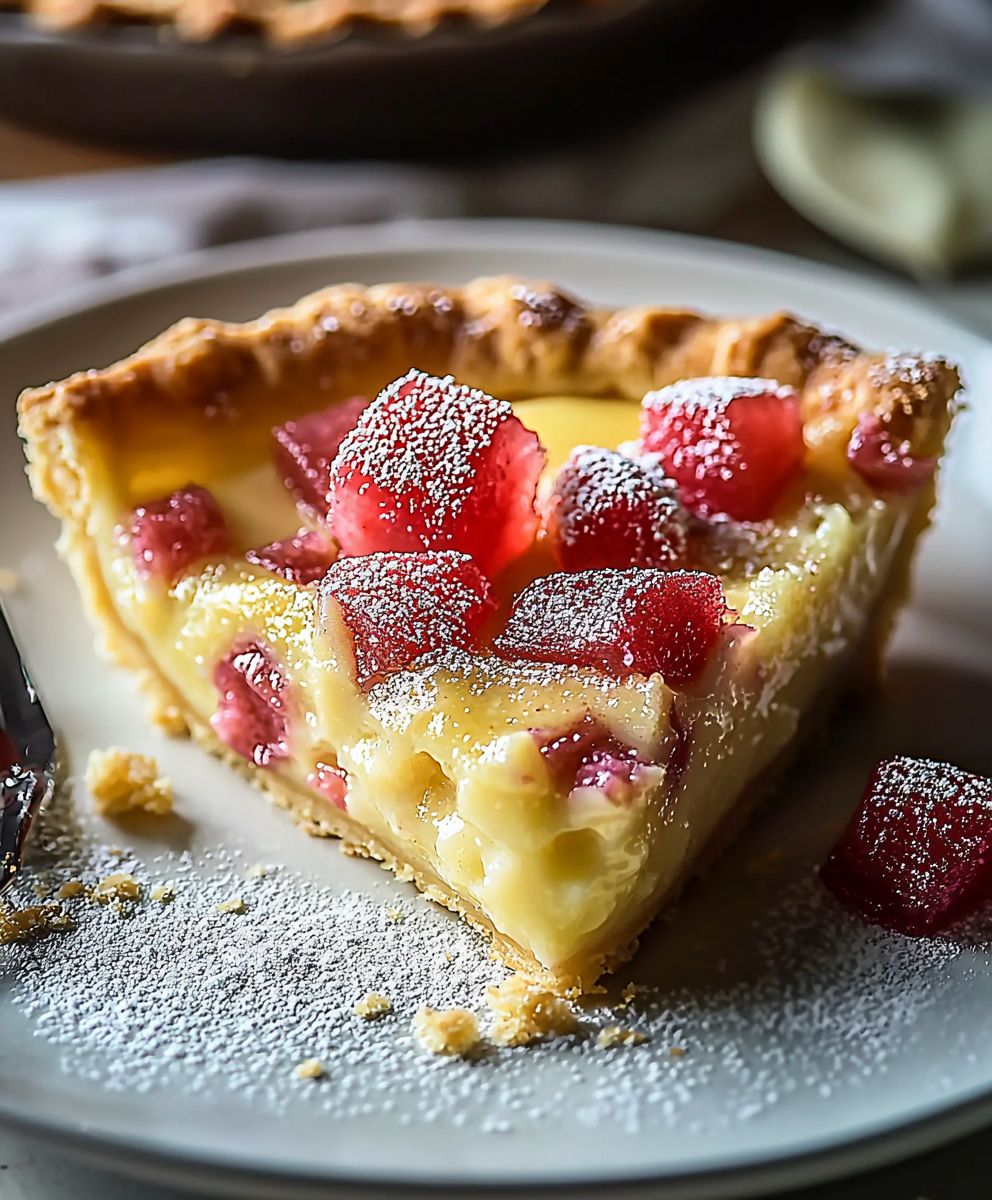
Conclusion:
This Rhubarb Custard Pie isn’t just a dessert; it’s a taste of spring, a comforting hug on a plate, and a guaranteed crowd-pleaser. The tangy rhubarb perfectly balances the sweet, creamy custard, creating a symphony of flavors that will have everyone begging for a second slice. I truly believe this is a must-try recipe for anyone who appreciates classic baking with a delightful twist.
But why is this pie so special? It’s the simplicity, really. No complicated techniques, no hard-to-find ingredients, just honest-to-goodness deliciousness. The vibrant pink rhubarb against the golden custard is visually stunning, making it the perfect centerpiece for any gathering. And the aroma that fills your kitchen while it bakes? Pure bliss!
Beyond its inherent deliciousness, this pie is incredibly versatile. For a simple yet elegant serving suggestion, try topping each slice with a dollop of freshly whipped cream and a sprinkle of nutmeg. The creamy whipped cream complements the tartness of the rhubarb beautifully. Or, if you’re feeling a bit more adventurous, a scoop of vanilla bean ice cream adds a delightful coolness and richness.
Looking for variations? Absolutely! If you’re not a fan of rhubarb (though I highly encourage you to give it a try!), you could substitute it with other fruits like strawberries, raspberries, or even a combination of berries. Just be sure to adjust the sugar accordingly, as some fruits are naturally sweeter than rhubarb. Another fun variation is to add a streusel topping for extra crunch and sweetness. Simply combine flour, butter, sugar, and a pinch of cinnamon, then sprinkle it over the pie before baking.
For those who prefer a gluten-free option, you can easily adapt this recipe by using a gluten-free pie crust. There are many excellent pre-made gluten-free crusts available, or you can make your own using a blend of gluten-free flours. Just be sure to follow the instructions on the package or recipe for the best results.
Don’t be intimidated by the thought of making a pie from scratch! This recipe is designed to be easy and approachable, even for beginner bakers. I’ve included detailed instructions and helpful tips to guide you through each step of the process. And remember, even if your pie isn’t perfect the first time, it will still taste amazing!
I’m so excited for you to try this Rhubarb Custard Pie recipe. I know you’ll love it as much as I do. It’s a recipe that’s been passed down through my family for generations, and I’m thrilled to share it with you.
So, gather your ingredients, preheat your oven, and get ready to create a truly memorable dessert. And most importantly, have fun! Baking should be a joyful experience, so relax, put on some music, and enjoy the process.
Once you’ve made your pie, I’d love to hear about your experience! Share your photos and comments on social media using [Your Hashtag Here] or leave a review on the recipe page. I can’t wait to see your creations and hear what you think of this delightful Rhubarb Custard Pie. Happy baking!
Rhubarb Custard Pie: The Ultimate Guide to Baking Perfection
Classic Rhubarb Custard Pie with flaky crust, tart rhubarb filling, and creamy custard topping.
Ingredients
- 1 1/4 cups all-purpose flour
- 1/2 teaspoon salt
- 1/2 cup (1 stick) cold unsalted butter, cut into small cubes
- 1/4 cup cold vegetable shortening, cut into small pieces
- 4-6 tablespoons ice water
- 4 cups fresh rhubarb, trimmed and cut into 1/2-inch pieces
- 1 cup granulated sugar
- 1/4 cup all-purpose flour
- 1/4 teaspoon ground nutmeg
- 1/4 teaspoon ground cinnamon
- 1 tablespoon lemon juice
- 3 large eggs
- 1 1/2 cups heavy cream
- 1/2 cup granulated sugar
- 1 teaspoon vanilla extract
- Pinch of salt
- 1 tablespoon milk or cream, for brushing the crust
- 1 tablespoon granulated sugar, for sprinkling on the crust
Instructions
- In a large bowl, whisk together the flour and salt.
- Add the cold butter and shortening to the flour mixture. Using a pastry blender or your fingertips (work quickly to keep the fat cold!), cut the fat into the flour until the mixture resembles coarse crumbs.
- Gradually add the ice water, one tablespoon at a time, mixing gently after each addition. Use just enough water to bring the dough together.
- Once the dough starts to come together, gently gather it into a ball. Flatten the ball into a disc, wrap it tightly in plastic wrap, and refrigerate for at least 30 minutes, or up to 2 hours.
- On a lightly floured surface, roll out the dough into a 12-inch circle.
- Carefully transfer the rolled-out dough to a 9-inch pie plate. Gently press the dough into the bottom and up the sides of the plate.
- Trim any excess dough from the edges of the pie plate. Crimp the edges using your fingers or a fork to create a decorative border.
- Preheat your oven to 375°F (190°C). Line the pie crust with parchment paper and fill it with pie weights or dried beans. Bake for 15 minutes.
- Remove the parchment paper and pie weights. Prick the bottom of the crust with a fork to prevent it from bubbling. Return the crust to the oven and bake for another 5-7 minutes, or until lightly golden brown.
- Let the pre-baked crust cool completely before adding the rhubarb filling.
- In a large bowl, combine the chopped rhubarb, granulated sugar, flour, nutmeg, and cinnamon. Toss gently to coat the rhubarb evenly with the dry ingredients.
- Stir in the lemon juice.
- Pour the rhubarb mixture into the pre-baked pie crust, spreading it evenly.
- In a medium bowl, whisk together the eggs until light and frothy.
- Gradually whisk in the heavy cream and granulated sugar until well combined.
- Stir in the vanilla extract and salt.
- Gently pour the custard mixture over the rhubarb filling in the pie crust.
- Preheat your oven to 350°F (175°C). Bake the pie for 45-55 minutes, or until the custard is set and the crust is golden brown. If the crust starts to brown too quickly, you can cover the edges with aluminum foil.
- Let the pie cool completely on a wire rack before slicing and serving.
- Before baking, brush the crust with milk or cream and sprinkle with granulated sugar for a golden and sparkly finish.
Notes
- Use cold ingredients for the crust.
- Don’t overwork the dough.
- Pre-bake the crust to prevent a soggy bottom.
- Adjust sugar in the rhubarb filling to taste.
- Protect the crust edges with foil if they brown too quickly.
- Cool the pie completely before slicing.
- Serve chilled or at room temperature.
- Store leftovers in the refrigerator for up to 3 days.
- Variations: Add berries, use a different crust, add almond extract, or make mini pies.

